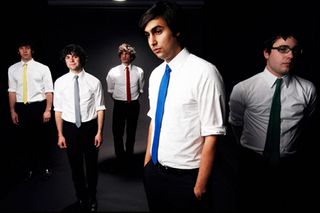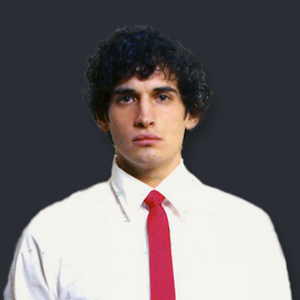Join the HITS Discord and leave your suggestions for this wiki, talk about your edits, or just chat with fellow Tally Hall fans!
Difference between revisions of "Tally Hall"
(linked images to their bio pages) |
(replaced inline styles with classes for flexbox to make the headshot images smaller for this page) |
||
| Line 17: | Line 17: | ||
The band is made up of 5 members: | The band is made up of 5 members: | ||
<div | <div class="flexRowContainer"> | ||
<div | <div class="flexItem"> | ||
[[Image:Rob_cantor_portrait_01_hallmanac.png|thumb|left|link=Rob_Cantor|[[Rob Cantor]]<br>Yellow Tie - Vocals/Guitar|alt=Rob Cantor]]</div> | [[Image:Rob_cantor_portrait_01_hallmanac.png|thumb|left|link=Rob_Cantor|[[Rob Cantor]]<br>Yellow Tie - Vocals/Guitar|alt=Rob Cantor]]</div> | ||
<div | <div class="flexItem"> | ||
[[Image:Joe_hawley_portrait_01_hallmanac.png|thumb|left|link=Joe_Hawley|[[Joe Hawley]]<br>Red Tie - Vocals/Guitar|alt=Joe Hawley]]</div> | [[Image:Joe_hawley_portrait_01_hallmanac.png|thumb|left|link=Joe_Hawley|[[Joe Hawley]]<br>Red Tie - Vocals/Guitar|alt=Joe Hawley]]</div> | ||
<div | <div class="flexItem"> | ||
[[Image:Andrew_horowitz_portrait_01_hallmanac.png|thumb|left|link=Andrew_Horowitz|[[Andrew Horowitz]]<br>Green Tie - Keyboards/Vocals|alt=Andrew Horowitz]]</div> | [[Image:Andrew_horowitz_portrait_01_hallmanac.png|thumb|left|link=Andrew_Horowitz|[[Andrew Horowitz]]<br>Green Tie - Keyboards/Vocals|alt=Andrew Horowitz]]</div> | ||
<div | <div class="flexItem"> | ||
[[Image:Zubin_sedghi_portrait_01_hallmanac.png|thumb|left|link=Zubin_Sedghi|[[Zubin Sedghi]]<br>Blue Tie - Vocals/Bass Guitar|alt=Zubin Sedghi]]</div> | [[Image:Zubin_sedghi_portrait_01_hallmanac.png|thumb|left|link=Zubin_Sedghi|[[Zubin Sedghi]]<br>Blue Tie - Vocals/Bass Guitar|alt=Zubin Sedghi]]</div> | ||
<div | <div class="flexItem"> | ||
[[Image:Ross_federman_portrait_01_hallmanac.png|thumb|left|link=Ross_Federman|[[Ross Federman]]<br>Grey Tie - Percussion|alt=Ross Federman]]</div> | [[Image:Ross_federman_portrait_01_hallmanac.png|thumb|left|link=Ross_Federman|[[Ross Federman]]<br>Grey Tie - Percussion|alt=Ross Federman]]</div> | ||
</div> | </div> | ||
Revision as of 00:52, 22 March 2022
| Tally Hall | |

| |
| Place of Origin | Ann Arbor, Michigan (USA) |
|---|---|
| Genres | Rock, Indie Rock |
| Years Active | 2002-Present |
| Label | Quack! (2005-2007, 2011) Atlantic Records (2007-2010) Needlejuice Records (Present) |
| Website | Official Website Tally Hall's YouTube Tally Hall's Twitter Tally Hall's Facebook |
| Band Members | |
| Joe Hawley: Vocals, Guitar Rob Cantor: Vocals, Guitar Ross Federman: Drums/Percussion Andrew Horowitz: Keyboards, percussion, vocals Zubin Sedghi:Vocals, Bass | |
| Past Members | |
| Steve Gallagher: Drums/Percussion
Honorary Members | |
Tally Hall is an American rock band formed in December 2002 in Ann Arbor, Michigan and is often recognized by their trademark colored ties. They currently signed to Needlejuice Records but have also been under the indie label Quack! Media in the past (2005-2007, 2011), as well as Atlantic Records (2007-2010) who helped finance and nationally re-distribute their studio debut album, Marvin's Marvelous Mechanical Museum.
The band is made up of 5 members:
History
On the Tally Hall website, there have been two biographies posted; one in 2006[1] and one in 2008, the latter of which is written by friend of the band Bernie J. Michael, who is not fictitious.[2][3]
2006 Bio
It was a small, sweaty club in the middle of Detroit. On maybe a Tuesday. The crowd was on the edge of their feet. And after waiting forever, the main attraction took the stage, a band that dares to challenge. A band that never should have been. A band that got where they were on hard work. The Polyphonic Spree. And they stayed there and brought joy for almost two hours, never a dull moment, always inspiring. When they finished, Tim Delaughter and his crew left the stage. And the show would have ended there, except five collegiate students caught the attention of Mr. Delaughter. "Tally Hall, Tally Hall, Tally Hall. I love it. Tally Hall. It's got a ring. Who are they? What is it?" It was the t-shirt of Joe Hawley, guitarist for Tally Hall. Who are they and why do we care?
Well, first off, let's get the basics out of the way. They are five college students, three studying pre-med, one a film and writing major, and a music composition and English major. Tally Hall officially began in December 2002 when Rob Cantor, Zubin Sedghi, and Andrew Horowitz performed a set of originals and covers at a small theater in Ann Arbor, Michigan. During that show…(flashback)
(Middle of some cheesy Third Eye Blind cover, Rob's cell phone goes off. He stops the song to the dismay of Andrew and Zubin and actually answers the phone, holding it up to the microphone. The audience laughs.)
Rob: Hello?
Joe: Jam. What's up.
Rob: Umm…we're in the middle of the concert.
Joe: No, seriously. What's up? How did it go? Sorry I couldn't make it.
Rob: No seriously, you're talking to the microphone.
Joe: Gotta go.
(Joe hangs up phone. Rob smiles. Lights out.)
Well, Joe wound up joining Tally Hall as the guitarist. And then a man by the name of Steve Gallagher, residing with Rob and Andrew, decided he wanted in on the drums. And so it was. Tally Hall.
The first show as a full band took place at a frat. The band made an early decision to play music with an emphasis on craft, and with five perfectionists, so it was. And the audience at the frat was not too appreciative. But the band trudged on.
Show after show their wonky 3-part harmony and crafty songs began catching on and a following was built. Their first few months included three performances at Ann Arbor's rock Mecca, The Blind Pig.
In April 2003 they recorded Partyboobytrap e.p. The name was chosen strictly because it is a palindrome. A year passed with more concerts. And in April 2004 came Welcome to Tally Hall e.p. And then they combined the CDs and added a bonus track and got Complete Demos, which is what the tracks are. They were all recorded on a video camera, each track one by one, and self-edited/produced by the band in their attic.
After a May 2004 gig in New Jersey, the band replaced Steve with the nimble Ross Federman. Steve, after amiably leaving the band, became a traveling salesman. Believe it. That's what happens when you quit Tally Hall.
Also in that May, the band received their first national exposure as the in-studio guest on the Mitch Albom Radio Show. Mr. Albom said, "They look like their twelve, but these guys are very talented. You'll be hearing a lot from them."
And the band further received national exposure when Andrew's "Good Day" won 1st place in the John Lennon Scholarship Competition, run by BMI and Yoko Ono. Frequently asked question regarding the adventure: "How was Yoko Ono?" Andrew's programmed reply is, "She's awesome."
More recently they have infiltrated the web, earning recommendations on dozens of websites, winning many songwriting awards, and having their videos watched all over the world through the web and at film festivals. Tally Hall has developed a huge local following of the best fans in the world. Their national and international following is substantial, and they plan on touring sometime in the near future. They are also working on a new CD, combining professionally recorded songs both new and old, all originals.
They are very appreciative of all the support and encouragement. It's nice to know a few guys with a vision in the Midwest can make their voices heard.
Finally, the name Tally Hall comes from an old funhouse which now goes by the name of Marvin's Marvelous Mechanical Museum. Also, the ties were inspired by the Teenage Mutant Ninja Turtles, because everyone likes the Ninja Turtles. Including Tally Hall. And there you have it, the little independent band that could, "Tally Hall, Tally Hall, Tally Hall…"
contact: tallyhall@umich.edu
2008 Bio
I sat in a Penguinarium in New Jersey with my penpal Andrew Horowitz. I was twelve, and he was fourteen. He fiddled with a plastic-cased glockenspiel and a green tape recorder while I read an old paperback biography of The Beach Boys with an Isaac Asimov quote in the back of my head: “The most exciting phrase to hear in science, the one that heralds new discoveries, is not ‘Eureka!’ (I found it!) but ‘That’s funny. . . .’” Listening to Andrew play those shrill bells all day while penguins waddled in darkness cracked me up. In a good way. When Brian Wilson was working on Smile in 1966, he was making an album that would make people laugh. Pet Sounds had dark currents of emotion: teenage drama. Smile was light and effervescent– Spaghetti Westerns, raw vegetables, and pocket symphonies. Horowitz, despite his bizarre affinity for Penguinariums, would later attempt similar musical feats with a band comprised of a few of my friends: Tally Hall.
***
In 2008, after two EPs, a demo album, and an album released on Michigan’s Quack! label[1], a band comprised of five friends– Rob Cantor, Ross Federman, Joe Hawley, Andrew Horowitz, and Zubin Sedghi– released their debut album on Atlantic Records: Marvin’s Marvelous Mechanical Museum. Wonkiness and alliteration aside, the real Marvin’s Marvelous Mechanical Museum (in swinging Farmington Hills, Michigan) was a childhood mecca for the members of Tally Hall and myself. It was an electric dreamworld made of beat-up carousels, ominous robot fortune tellers, cotton candy, and model airplanes that flew around when the lights were off and the kids went home. Loose baby teeth. Hide-and-seek. Tickets for prizes. It was part “Being For the Benefit of Mr. Kite!”[2], part forgotten Ray Bradbury novel, and like every dream I could not remember upon waking up. MMMM is Tally Hall’s teenage canticle to our shadows– may we never forget them. They worked with music producer Chris Shaw (Bob Dylan, Weezer, Lou Reed) to make the album, and they even wrote and produced a psychedelic internet tv show to accompany their waggish work.
Oh, it’s dark whimsy. It shivers and hums– Marvin’s Marvelous Mechanical Museum. My friends, Tally Hall, beginning to work in brilliant accord with each other. They are melodies, and they are harmonies. They’ve become their lyrics and laughter. But I knew them well before all that.
I met Joe Hawley when I was six-years-old. Our parents knew each other, and he lived in a cavernous old house of crooked mahogany and dark paisley wallpaper. From my six-year-old perspective, his house was scary as hell. And his parents’ strange professions didn’t exactly put me at ease during those first sleepovers. Mr. Hawley was an old, and long-since retired, magician-turned-orchid hunter. Alone at 3 o’clock in the morning, Mr. Hawley would put on a cape, play calliope, and practice old tricks to a vinyl copy of Queen II in the Hawley family ballroom. Joe and I would watch secretly from the shadows. Joe’s mom was a research scientist in cryogenics– actually, that’s all she and my dad talked about. Occasionally, a sleek mechanical sarcophagus would spend the night in Mr. Hawley’s orchid-filled greenhouse, but it would never be in there long enough for us to look inside.
Joe got into making movies– capturing light and time, as he thought of it– when he was twelve. I was in one of his first films: Frozen Tentacles and the Orchid-Covered Gravestone. We co-wrote the script together in the summer of 1996[3]. In the film, I play a psychotic scientist who can become invisible or mutate into an Antarctic octopus at will. We shot the bulk of the film in graveyards. I drove a submarine made of cardboard, blue paint, and a telescope around cemeteries looking for “the graves” of old archenemies that I had killed– only to resurrect them and kill them again. We screened the film in Marvin’s Marvelous Mechanical Museum. It received mixed reviews.
Joe’s dad gave us a rare, bright red orchid in honor of our efforts. Joe’s mom said that she wished she could freeze the summer and thaw it out when we were all old and grey. While she was saying this in Joe’s kitchen, Rob Cantor stole the cardboard submarine from our film and later hawked it for a case of Hi-C Ecto Cooler, the board game Crossfire, and a battered Harmony acoustic guitar. To this day, we all agree it was a great heist and an even better trade.
Rob Cantor was one of those kids who had a monopoly on great ideas. In all seriousness, we became friends by haggling over the price of lemonade. He ran an amazing curbside stand– one of a multitude of business ventures he had going at the time[4]– that gave away free goldfish with every cup. I got all my pet goldfish by buying Rob’s “Patented Lemon Wondermiddel[5],” and one fish, a white-spotted Comet named Zinc, is still alive. To bolster his credibility, Rob even took to wearing fine hats (trilbies and bowlers mostly) and waistcoats everywhere he went. He even had a Purple Heart that he traded off of a retired General who lived in the neighborhood.
I worked at Rob’s stand for a little while during the sixth grade, but we didn’t become “best friends” until he fell out of an oak tree that grew next to his stand. He was finishing a new promotional scheme, hanging lemons with cinnamon dental floss from the oak’s highest branches, when he “slipped as to avoid crushing a Blue Jay’s nest.”
Rob broke his collar bone, cracked seven ribs, and suffered a concussion from the fall. He was in the hospital for a month, and to this day, he swears he heard Strauss’ “Where the Lemon Trees Bloom Op. 364” play from a distance as he fell through the thick tangles.
I visited him almost every day. He got pretty good with that Harmony acoustic during his stay and was particularly delighted when I brought him the broken remains of a periwinkle-hued eggshell I found under his oak tree. One Saturday, I played him a tape that my penpal, Andrew Horowitz, had sent me. Rob didn’t care for it much. To him, it sounded like a bunch of prickly sounds arranged randomly, but something (whether it was the dog barks or the church organs or the shoes crunching leaves, I’ll never know) on Andrew’s tape got me to visit him in New Jersey the next summer.
When I first met Andrew’s parents, I thought they liked me more than he did. His mother said I looked “dapper” even though I was wearing a ripped Fresh Cream t-shirt and ill-fitting khakis. Andrew’s dad was a used car salesman. He’d take old beaters, fix ’em up new, and paint ’em wild colors. He’d work in his garage listening to old hot-rod records all day. Andrew’s mom designed board games[6]. She even helped Andrew’s dad fix up the family cars: a vintage finned Cadillac painted to look like a black whale and a VW van colored like the night’s sky.
I spent two weeks at Andrew’s place. He was quiet at first and mostly asked my opinions of his tapes. He would make little orchestral pieces by looping everyday noises from the neighborhood. His songs reminded me of the old Disney cartoon series Silly Symphonies. Mostly because they were bizarre and crazy: the sounds of buzzing bees, watermelon seeds being spit, wind chimes in a storm, and kids jumping into a pool were turned into little pop songs with Andrew singing softly over the cacophony-turned-melody.
Andrew’s dad drove us to the zoo every couple of days with sack lunches. We’d spend hours in the Penguinarium. Talking and listening. More listening than talking. I distinctly remember Andrew putting on Surf’s Up every night while we fell asleep. One night, while Andrew drifted off as “A Day in the Life of a Tree” played, I cried quietly and breathed deep breaths through my nose. I didn’t know how I could feel so old at twelve. It felt like I had been alive for a million years, and it felt like Andrew and I were little old men who somehow still had their whole lives ahead of them. I fell asleep missing my own bed and my younger brother. The next day, I helped Andrew record a song at the zoo outside of the lions’ cages. I wrote Andrew postcards and visited him twice more in New Jersey before we met up again in college. We were both lonelier kids than we ever let on and having Andrew as a friend helped me to appreciate how beautiful thoughts can be when you’re young and lonely.
***
Ross and Zubin, drums and bass respectively, were each a different type of childhood friend altogether. The kinds of friends who are mythic by their association to the most freewheeling childhood season: Summer. Ross and Zubin were the best of my best July friends. Though, they were (as most devastating duos are at their onset) archenemies when I first met them.
Up on a mossy pond near the strawberry-shaded banks of Lake Huron, Ross Federman had a chipped-up rowboat that any self-respecting ten-year-old would lust after. Before I was friends with him, I agonized over its whimsical knots and lacquered grandeur. It was small, but it was Ross’. Ross was a collector of sorts, and what he collected skirred over the pond waves with him. He had jars all over the boat filled with grass, sticks, and pet crickets. He named all of his crickets: Marshmallow, Oberon, James T. Kirk, Motorpsycho Nightmare, and Winston to name a few of his favorites. He had an old lantern mounted on an iron post that he claimed was from 18th century London, but I’ve always thought that to be one of his most winsome white lies. And (perhaps Ross’ coolest stockpile) old drums were tied around his rowboat’s hull– rusty snares, slashed-up toms, cymbals, and a shoddy timpani in back. Ross said that to the aquatic life, the reflected light of silver steel cutting across water made his boat look like shoals of sparkling fish. I didn’t really believe this either, but it was all just Ross’ percussive catamaran.
He said he found a drum graveyard in a patch of backwoods behind an old abandoned music camp. At a barbecue three years later, Mr. Federman told me that Ross bought every drum he could find on weekend trips to junkyards in Detroit.
But, for all his hyperbole and preteen perjury, I didn’t give a damn. Ross chewed bubblegum cigars while we fished. When all the stars came out, he’d play tambourine and bongos for his singing crickets as we drifted through black water– campfires and mosquitoes in the distance, occasionally kids with sparklers. He’d catch me a big catfish for my birthday and put it in the kiddy pool behind my cottage. He told my cousins it was an ancient monster, and when it eventually died, he’d bury it in my mom’s garden and hold an impromptu funeral service before we cut the cake. Unfortunately, Zubin did give a damn.
Of all my friends in Tally Hall, Zubin was, and is, the most cryptic. I never knew his siblings or parents, and his presence in Summer was chimeric– like smoke coming off a burning marshmallow or the faint perfume of chlorine from a pool that you’ll never swim in. He kept a fort in the burnt-out basement of an abandoned cottage on the far side of the pond. You know the cottage: overgrown, half a roof, missing windows, courted by adult rationales and kid-spread monster stories. In this rooky cellar, Zubin told stories with no words.
On sticky grey afternoons when you could smell a storm in the air, Zubin would invite friends to his hideout. Thunder rolled gently, and “The Umbrella Gang,” skinny pond-goers seeking sanctuary, would fill the basement. It held the essentials: a red metal cooler filled with ice and soda in glass bottles, Zubin’s grandpa’s stand-up bass, a battery-powered blue plastic record player, Zubin’s record collection, countless flashlights and umbrellas, and Zubin’s grandpa’s WWII sleeping bag. Kids would sit on towels and ride out the storm as Zubin played his grandpa’s bass to Motown records. To Zubin, bass melodies told the truest stories that could be told– more pure and expressive than even a song’s lyrics. To Zubin, Ross was no storyteller. Ross was a liar. He’d tell me this again and again when I was the only subterranean gangster to weather a storm with him. During one storm where I was convinced thick lightning was going to crush us both, I made him stop playing along to the appropriate Temptations cut “I Wish it Would Rain” replacing it instead with The Marvelettes’ “Beechwood 4-5789.”
We never found out who did it, but there have been many speculations over the years. At the tail-end of a lazy drizzle in August 1998, Ross heard a cannonade. He found his boat on fire, sinking, and with a hula-hoop-sized hole in its hull. One of The Umbrella Gang had sunk the leviathan with a pair of Genuine M-80s. I still remember Ross’ impromptu eulogy– itself a bastardized A. W. Pugin quote: “There is nothing worth living for but Christian Architecture and a boat. And I’ve never been able to recognize Christian Architecture.” Out of respect and associative responsibility, Zubin and other members of The Umbrella Gang dove in, salvaged what they could, and moved it all down into Zubin’s cellar[7]. Ross’ unnamed wreck still lies in its crypt of seaweed. And in the newly shared summertime hangout, it was only a week before Zubin and Ross turned their animosity into a sparky rhythm section. “Provocateurs at harmonious odds.” That’s what Andrew made of the situation when I wrote him about it.
***
And that’s Tally Hall’s mini biography. Later, my friends met in college, formed a band, and played wonky rock-and-roll for everyone. They wear color-coded ties that serve as indicators of individual chromatic interests and, more importantly, reminders of ideas, humor, and humourous ideas. “Making people laugh and smile is the only thing worth getting out of bed for,” Joe told me a long time ago. And, as far as my personal accounts go, it reminds me of a quote from a book I once borrowed from Joe’s dad, The Amateur Magician’s Handbook: “Memory is an internally edited record of interest (not of attention, much less of ‘events’)” (Hay 3). These are my most heartfelt and ridiculous memories of Rob, Ross, Joe, Andrew, and Zubin. It’s when my friends were electric and red-blooded. And my interests and old recollections become new again whenever I listen to Marvin’s Marvelous Mechanical Museum or see Tally Hall play live. They recreate the memories and emotions I’ve wrote down in this biography at each and every show.
Talk to them after a show. You’ll see that they believe in you as much as they believe in themselves, and with that, you’ll have known them just as long as I have. They drove me to think only my wiliest thoughts and smile at times when near everybody was lionizing practicality and dead dreams.
Their songs are dreams of themselves dreamt in the lifetimes of an instant. Their songs are songs to transform your world... as they’ve transformed mine. I’ll always be “looking through glass eyes/ giv[ing] it a few tries” (“Good Day” Horowitz).
To conclude, I’ll paraphrase a quote Abraham Lincoln should have said in 1865: “Imagine if the great War Between the States were fought with songs instead of guns– bands instead of battalions. The casualties would have been aesthetic growth and the outcome would have been an unimaginable tomorrow. A better tomorrow in all ways. A tomorrow with better music. A tomorrow with more living than dead. A tomorrow with a freedom so wild that it’s almost inconceivable.” Lincoln on psychotropics. Lincoln listening to Pet Sounds alone on a train writing an anachronistic address for 1966 Gettysburg. Just a stovepipe hat, a Stratocaster, and an absurd and beautiful daydream draped in colors that managed to seep through the sepia of hypothetical histories.
Dedicated to: The Slurpee, 1967’s frozen carbonated beverage of wonder Millard Fillmore, infamous Know Nothing & our 13th President and Marvin Yagoda, an old pharmacist with the best cure you’ll ever know
ABOUT THE AUTHOR BERNIE J. MICHAEL grew up and went to school with TALLY HALL. He is a member of THE ROYAL LIONS and, currently, continues to dream and learn at the UNIVERSITY OF MICHIGAN, ANN ARBOR.
Footnotes
[1] A record company with quirk and heart to spare thriving in beautiful ruins that were once home to MC5, The Stooges, The Marvelettes, Marvin Gaye, Smokey Robinson, and The Gories–just to name a few... who put sincerity above pop propriety.
[2] A circus reverie remembered in reverse by The Beatles on Sgt. Pepper’s Lonely Hearts 2 Club Band.
[3] And by co-wrote, I mean, I ate blue popsicles and listened to Revolver while Joe brainstormed and tended to his father’s ancient orchids.
[4] He also ran a rock tumbling business that gave away homemade rock candy with every order of rocks tumbled, was assistant manager at Sparkle Laundromat, and started a telegram office out of his attic which catered to kids grades K through 12. All before he was eleven-years old.
[5] Wondermiddel, I later found out in college, is Dutch for “cure-all.”
[6] Ever hear of Haunted Treehouse or Soda!? Both independently distributed boardgames designed by Mrs. Horowitz.
[7] All but one of the cricket jars were salvaged.
Andrew, the only member not originally from Michigan, began writing songs when he was eight years old and eventually headed to the University of Michigan to study composition. There he met Rob and Zubin, who both attended the same high-school and played in a band called listedBlack. The three formed a band (name unknown) and played small shows around the University of Michigan dorms, where all 5 members went to school.
Rob met Joe on campus and as they began to become friendly, Rob learned of Joe's musical abilities and asked him and Steve Gallagher to join the band as lead guitarist and drummer, respectively. Later, they played a few gigs under the name Gallagher and then as 540 (the address of their house at the time). Joe originally suggested the name of the band be "Tally Hall" and everyone agreed (except Andrew, who was not from the area and didn't grasp the magic of what the REAL Tally Hall meant to people in the Detroit area).
Tally Hall was the name of an indoor shopping plaza/food court on Orchard Lake Road in Farmington Hills, Michigan. It was developed by Mel Rosenhaus (1925-2011) and, according to Mr. Rosenhaus' eulogy, was the first food court in Michigan. A wonderous arcade/museum of coin-op machines and oddities called Marvin's Marvelous Mechanical Museum was a popular establishment within Tally Hall and is now all that remains after the Tally Hall complex was torn down.
Eventually, they all agreed to name the band Tally Hall and they began to record some EP's and play small shows around the UofM campus.
The matching wardrobe/colored ties first started around November 2003.
In 2004, when Steve Gallagher left the band, they recruited Ross, who went to high school with Joe.
In 2005, the band would sign with up-and-coming multimedia company and record label Quack!Media for funding and the release of their first studio album, Marvin's Marvelous Mechanical Museum. Joe stated they needed to partner with a label to progress as a band together and Al McWilliams happened to accept their request of a record deal.[4]
From 2005 until 2010, the band was managed by The Hornblow Group (They Might Be Giants, OK Go) but they changed management in Spring/Summer of 2010 to Stiletto Entertainment.
In 2011, the band was released from Atlantic Records and went back to Quack! Media to release their 2nd full-length album, Good & Evil.
Complete Demos
The LP known as Complete Demos is essentially just a compilation of the songs they recorded for the two EPs they previously released (Party Boobytrap & Welcome To Tally Hall) with the addition of the unnamed hidden track, referred to as Hidden In The Sand. But unlike the EPs, they put effort into manufacturing & packaging and officially released the album on November 11th, 2004. The CD was sold at shows and through their website for about a year. The album was then considered out of print and hard to find until December 2015 when they uploaded it and made it available to purchase through Bandcamp. [5]
Marvin's Marvelous Mechanical Museum
2005
The band began touring outside their general hometown area in 2005, promoting this album, which was initially released in November 2005 under the Quack! Media label in Ann Arbor, MI. Their shows mostly featuring tracks from the album. However, their live concerts often feature a couple cover songs. They're probably best known for their cover of Biz Markie's "Just A Friend", which they used to end every set with but it's not played too often anymore.
A live version of Just a Friend can be found on The Pingry EP released in 2005. Later, In 2006, a studio version was recorded and shelved -- because the band was not happy with it -- but later was released as one of a few bonus songs provided by Atlantic Records for their 2008 re-release of MMMM. These bonus songs (Just A Friend, Mucka Blucka, and Dream) were distributed via download codes handed out at live shows and through the Twitter account of hiddeninthesand.com (A.K.A. HITS).
2006
Quack! Media re-released the album in September 2006 with more focused marketing behind it and a wider distribution plan. It helped get them into more stores and gained them more national attention, including impressing radio personality Mancow enough for him to recommend Craig Ferguson listen to the album. Soon after, on August 2, 2006, they were performing their song "Good Day" on The Late, Late Show with Craig Ferguson. In September 2006, Tally Hall appeared in MTV's segment "You Hear It First."
2008
After signing to Atlantic Records, the band released Marvin's Marvelous Mechanical Museum for the 3rd time on April 1, 2008 with their new record label, but this time they were given the opportunity to re-record and re-mix parts they've never been quite satisfied with and allow a more experienced engineer to gear the songs in a radio-friendlier manner, though the songs did not gain much more radio airplay. In addition to the album, Atlantic Records produced Tally Hall's Internet Show, which was intended to coincide with the release of the album but due to some musical licensing issues, there was a delay and the Internet Show didn't get started until September 2008.
The band also appeared at a few South by Southwest Music Festivals and on August 3, 2008, Tally Hall was a performer on the BMI stage at Lollapalooza.
Tally Hall was invited back by The Late, Late Show with Craig Ferguson on September 16, 2008 to help promote the launch of Tally Hall's Internet Show. They performed a "radio edit" version of "Welcome to Tally Hall" in newly donned black vests over top of their traditional colored ties, white shirts, and black pants. This was the first time the vests were worn.
The band worked on several projects after the completion of "Marvin's Marvelous Mechanical Museum", including covering the song "Smile Like You Mean It" by The Killers for the sixth The O.C. soundtrack: Music from The OC: Mix 6. They also recorded a song in 2009 called Light And Night featuring Nellie McKay as a free download, distributed by Walmart, when people bought the book "The Magician's Elephant."
Good & Evil
Tally Hall's second album Good & Evil was released on June 12, 2011[6]
Post-Good & Evil
Tally Hall went on hiatus in fall 2011, but the band members have worked on other personal and musical endeavors.
In March of 2012, Andrew Horowitz released sketches under the name edu. This album would be released only as a cassette tape until December of the same year, where it was released digitally. The album featured Rob Cantor on HEY YOU!.
In 2012 Joe Hawley, Ross Federman, and Bora Karaca released Hawaii: Part II under the name ミラクルミュージカル, (Miracle Musical).
In 2014 Rob Cantor released his solo album Not A Trampoline, and the now-famous Shia LaBeouf Live single and music video.
In 2016, Joe Hawley would start a PledgeMusic project for funding a solo album. This would be released as Joe Hawley Joe Hawley in the same year.
On December 13th, 2018, as part of ミラクルミュージカル's Reddit AMA, when asked whether Tally Hall is still around, Ross answered: "Tally Hall still exists. Touring isn't possible at this very moment. That's about the only update".[7]
On May 30, 2019, Andrew Horowitz would start a Kickstarter to produce vinyl and CDs of his album sketches. However, sketches would be remixed, remastered, and retitled to sketches 3d. On June 30, 2019, he hit his Kickstarter goal.[8]
On July 26, 2019 Andrew released sketches 3d digitally and would start to ship out backers physical copies. CDs and vinyl would later be listed on Andrew's store as he had some left over.
On November 6th, 2019, the official Tally Hall Twitter announced that their songs would be available on AMI digital jukeboxes. [9]
Sometime in late 2020, the band would sign with Needlejuice Records, who would announce and open pre-orders for a reissue of Marvin's Marvelous Mechanical Museum in early 2021. The pre-orders opening would crash their website and prevent some from pre-ordering the album. A EP combining Just a Friend and some bonus tracks would be announced as well and released alongside the reissue. Good & Evil is currently planned to be reissued before the end of 2022, but there are no set-in-stone dates for when this will be. The album will be released alongside a EP of Good & Evil-era non-album tracks.
Discography
LPs
EPs
Compilations
- Complete Demos
- Songs From The O.C. Mix 6
- Admittedly Incomplete Demos
Singles
Promotional CDs
Miscellaneous Collections Of Songs
Side Projects, Solo Albums, & Old Bands
- ミラクルミュージカル (Miracle Musical)
- Tally Hall's Internet Show
- Happy Monster Band
- listedBlack
- Toy Orchestra
- The Baker Bros.
- The Robbie Cook Band
- anonyMous
- Source
- Welcome To Now
- Andrew Horowitz's edu
- Rob Cantor's Not A Trampoline
- Joe Hawley's Joe Hawley Joe Hawley
- Ross Federman's Mr. F
- Rob Cantor and Ricky Lax's Mr. President, There’s an Asteroid Headed Directly For the Earth: The Musical
Equipment List
The following is a list of equipment the members of Tally Hall use or have used.
Percussion
- Ross plays a 5-piece Pearl Reference kit in Granite Sparkle.
Drum sizes:
- 22x18 bass drum
- 10x8 tom
- 12x9 tom
- 16x16 floor tom
- 14x6.5 snare drum
- Primero Pro 7"/8.5 bongo
He also uses a Roland SPD-S sampler to trigger samples throughout the show.
Guitars
- Joe plays a Rickenbacker 330 or a Fender Stratocaster through a Fender Hot Rod DeVille
- Rob plays a Gibson Les Paul through a Vox AC30
Both guitar players use Boss GT-6 multi-effect units.
Bass Guitars
- Zubin plays a black Fender Jaguar bass through an Ampeg SVT450H head with SVT 410HLF cabinet. He uses a Boss GT-6B multieffect unit.
Keyboards
- Andrew plays a Yamaha S90 ES electric piano and an Alesis micron through a Roland KC-550 keyboard amplifier. He also uses a Roland SP404 sampler to trigger samples and for the vocal pitch shifting effect on Spring and a Storm. On more recent tours he's also been experimenting with using Apple's Logic Mainstage keyboard software.
Mics
The boys sing through Sennheiser e935 vocal microphones. Ross prefers Sennheiser e904 tom microphones.
References
- ↑ Tally Hall 2006 bio, archived at: skyetheguy.com
- ↑ Tally Hall 2008 bio, archived at: skyetheguy.com
- ↑ Hidden In The Sand Twitter, confirming that Bernie Michael is a real person.
- ↑ [https://www.youtube.com/watch?v=VS96m7T4yos Joe Hawley from Tally Hall on WXJR, 01/22/2009 . YouTube.]
- ↑ Tally Hall Complete Demos - bandcamp
- ↑ Good & Evil - iTunes.
- ↑ ミラクルミュージカル's Reddit AMA. Ross saying Tally Hall still exists.
- ↑ Sketches 3d Kickstarter page
- ↑ Tally Hall's twitter post.




